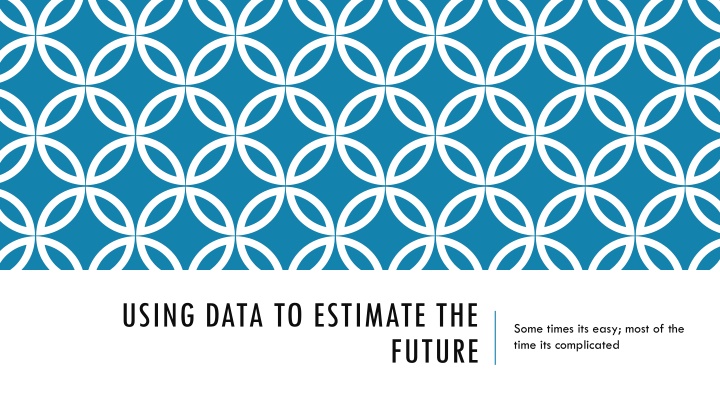
Using Data to Estimate the Future
In the realm of data analysis, forecasting the future can be both straightforward and intricate, requiring a blend of statistical techniques, trend analysis, and domain expertise. This process involves harnessing the power of data to derive insights that can help in making informed predictions and decisions. Understanding the patterns within the data provides a glimpse into what might lie ahead, paving the way for strategic planning and proactive measures. Leveraging historical data to anticipate future trends and outcomes is a valuable skill that can guide businesses, researchers, and decision-makers in navigating uncertainties with confidence.
Download Presentation

Please find below an Image/Link to download the presentation.
The content on the website is provided AS IS for your information and personal use only. It may not be sold, licensed, or shared on other websites without obtaining consent from the author. If you encounter any issues during the download, it is possible that the publisher has removed the file from their server.
You are allowed to download the files provided on this website for personal or commercial use, subject to the condition that they are used lawfully. All files are the property of their respective owners.
The content on the website is provided AS IS for your information and personal use only. It may not be sold, licensed, or shared on other websites without obtaining consent from the author.
E N D
Presentation Transcript
USING DATA TO ESTIMATE THE Some times its easy; most of the time its complicated FUTURE
First some basics on exponential growth For purely exponential growth at constant growth rate (which rarely occurs in the real macro world), the doubling time is a useful tool. Doubling Time = 70/n years; n = % annual growth for n = 1% the doubling time is 70/1 = 70 years. for n =2% the doubling time is 70/2 = 35 years for n =5% the doubling time is 70/5 = 14 years for n = 35% the doubling time is 70/35 = 2 years
WORLD POPULATION GROWTH RATE: HIGH WAS 2.1% (70/2.1) ~ 34 YEARS. NOW ITS 0.9% (70/.9) ~ 78 YRS
Finding the growth rate from the data. Now this data doesn t look either smooth or exponential but nonetheless you can use the data to determine a growth rate: Initial Value (1992) = 400 units Final Value (2001) =1600 units Total years = 9 ratio of final/initial = 4 natural log (ln) 4 = 1.39 Growth rate is then 1.39/9 = 15.4% annual doubling time is 70/15.4 = 4.5 years Indeed, the sample has doubled twice (400 to 1600) in 9 years or two doubling time which is consistent with the above.
But you have too look at data (plot the data) to make more informed decisions. Wind growth in Kansas 2000 - 2016; looks like a decent exponential fit and derived growth rate is 29.27%
It is often useful to look at time series data in segments; 2000-2008 vs 2011 -2016 to see that the exponential growth was not maintained
Compare linear vs exponential fits and decide which one is best; most recent data is the best indicator whether or not exponential growth has continued in this case it has not
Some times the data really cant be fit to make a good prediction. Any time series that that shows a few years of no growth (flattening of the curve) makes future predictions almost impossible.






















